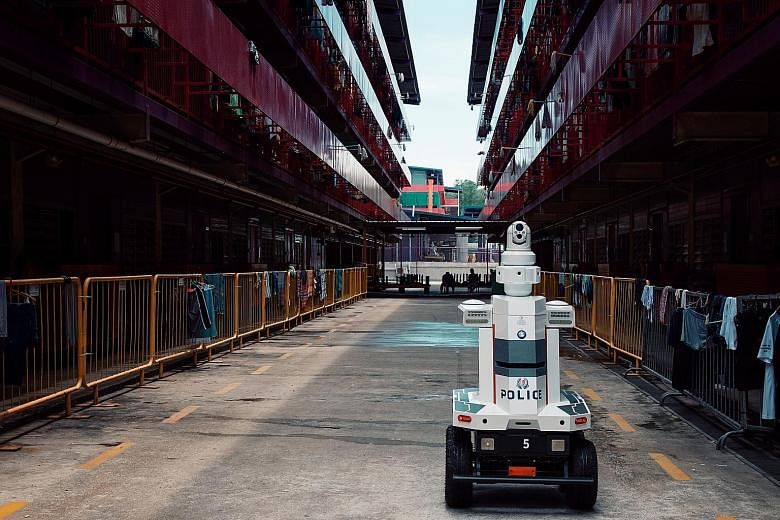The police are using robots to patrol a foreign workers' dormitory in the eastern part of Singapore to ensure that the premises are secure and the residents abide by safe distancing rules.
Two of these autonomous robots began working at the dorm - gazetted as an isolation facility for foreign workers in the fight against the Covid-19 outbreak - at the start of this month.
One of their major strengths is that they reduce the need for officers to be physically close to workers under quarantine, said Inspector Teo Wan Ling, who leads a team of more than 15 officers at the dorm.
She said the residents sometimes do not adhere to safe distancing measures, for example, while queueing up at mealtimes.
A verbal reminder from the robot, which has functions such as cameras and speakers, will do the trick, she added.
Insp Teo said that the workers generally tend to follow the safe distancing measures once they see the robots patrolling.
"They play a deterrent role," she added.
Called Multi-purpose All-Terrain Autonomous Robots, or Matar, these machines also help the police to cover more ground as they can patrol areas on their own, with an operator in a command centre observing their movements remotely.
Before being used at their current workplace, the robots had been at a government quarantine facility since mid-April.
Insp Teo said Matar can move only on flat ground, so if an incident happens in a room, the officers will attend to it personally.
The workers were initially curious about Matar, but slowly grew accustomed to the robots, said Insp Teo, who is a team leader at Changi Neighbourhood Police Centre.
The police also plan to use the robots' speakers to broadcast anti-scam messages in a few languages, said Assistant Superintendent of Police Daniel Toh, operations officer in the future operations and planning division.
"The robot helps us to automate some routine as well as mundane tasks, so officers don't have to travel and do the footwork. Instead, these robots can help to reduce human fatigue," he added.
Matar was developed by the Home Team Science and Technology Agency's Robotics, Automation and Unmanned Systems Centre of Expertise, together with ST Engineering and the Agency for Science, Technology and Research.
It can navigate autonomously and has a 360-degree camera, which covers blind spots during patrols. It can also avoid stationary and moving obstacles in its path.
Video and audio recordings are fed to the command centre, where an operator can view them live. The robot can raise a 2m-tall mast to provide a higher vantage point.
Each robot at the dorm can operate for up to four hours; they are rotated so that while one is on patrol, the other is being recharged.
Another version of Matar is on trial at Bedok Police Division Headquarters for the purpose of station security. This model has a tethered drone that can fly up to 30m high, instead of a 2m-tall mast.


